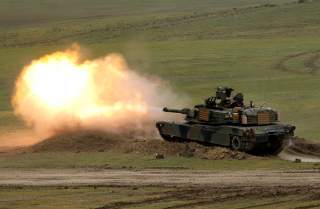Is America Losing Civilian Control of the Military?
A number of factors have led to a blurring of boundaries between the Congress, the president and the military.
The U.S. civil-military relationship allows for a candid dialogue on national security matters, yet readily defers to the tenet of civilian control of the military. This relationship is built on a delicate balance whereby strategic decision making is the purview of the civilian political leadership, while the execution of that portion of the strategy dealing with the use of force remains a uniformed mission.
The framers of the Constitution were keen to ensure that civilian control of the military was a core tenet of the use of military force, dividing up the powers into three components. Congress had the power "to raise and support Armies" and "provide and maintain a Navy." The president was to serve as the "the Commander in Chief of the Army and Navy of the United States, and of the Militia of the several States when called into the actual Service of the United States." Implicitly, the uniformed military was charged with the application of military force and following the orders of the civilian leadership.
A number of contributing operational, cultural and technical factors have led to a blurring of boundaries between the Congress, the president and the military in questions surrounding use of military force. These trends cannot be blamed on any single administration, yet over time there has been a gradual loss of balance within the nation's national security institutions.
In Vietnam, civilian leaders had their hands in tactical battlefield decision making. In turn General William Westmoreland, who commanded U.S. troops during the Vietnam War, was often criticized for being too political and not providing forthright military assessments. At one point Westmoreland even altered enemy order of battle and troop strength totals to reflect higher attrition levels.
In the George W. Bush administration, Secretary of Defense Donald Rumsfeld was criticized for delving into lower level operational decisions rather than providing strategic direction and allowing military planners to identify the size and composition of the force. This contributed to failure to plan for stability operations after the cessation of combat operations.
During the Obama administration, target packages for drone strikes were routinely reviewed by Pentagon and other national security officials. Some military leaders have questioned the “oversight” of operations in Iraq, Afghanistan and Syria for being overly constraining and inappropriate.
Modern command and control systems, which allow for real-time viewing and even directing of operational events, have further strained the civil-military balance. The now famous picture of President Obama in the White House situation room with key staff during the Osama bin Laden raid serves to illustrate this point.
Most recently, the selection of retired Marines Corps General James Mattis as Secretary of Defense, active duty Army Lieutenant General H. R. McMaster as President Trump's National Security Advisor and the other retired uniformed military officials with senior roles in the administration could further erode this civil-military balance. In the case of Secretary Mattis, a waiver of the National Security Act of 1947 had to be obtained as he had not been retired from the military for seven years before becoming secretary of defense.
Proper civil-military balance also implies having political appointees in place that can drive the president’s agenda. The relatively low number of appointees in these early days of the Trump administration contributes to difficulties in ensuring balance in the civil-military relationship.
Finally, President Trump’s decision to delegate more power to Secretary Mattis has the potential to further unbalance this civil-military relationship. There are two areas are of concern in this regard.
First, matters of national security strategy require more than decisions of a single department or agency. Delegating the authority for “tactical” decisions to Secretary Mattis could have strategic implications that ultimately cut across multiple departments and agencies.
Second, such devolution of authority would be of far less concern if the White House had a well articulated national security strategy. Presidential directives and executive orders that could guide departmental-level national security decisionmaking would include decisions regarding the use of force. Such a comprehensive national security strategy, by necessity, should include all of the elements of national power orchestrated in a coordinated manner.
Civilian control does not mean directing all operational details for the military. But it does mean establishing the direction and limits under which the armed forces should operate. A first step in restoring this civil-military balance could be the crafting a national security strategy that sets the strategic direction for national security institutions—including the Pentagon—and provides the necessary frameworks and guidance to operate globally in these precarious times. Importantly, such efforts also would serve to reassure friends and allies and place potential adversaries on notice.
Daniel M. Gerstein is an adjunct professor at American University. He was the undersecretary (acting) in the Science and Technology Directorate of the Department of Homeland Security and is a retired U.S. Army colonel.
Image: U.S. M1A2 "Abrams" tank fires during U.S. led joint military exercise "Noble Partner 2016" near Vaziani, Georgia, May 18, 2016. REUTERS/David Mdzinarishvili

